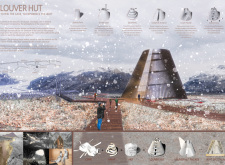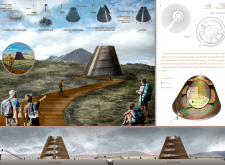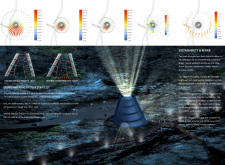5 key facts about this project
The Louver Hut is an architectural project located in Gjiotajgja, Iceland, designed to create a physical and experiential connection to the surrounding landscape. The structure emphasizes interaction with light and nature, capturing the essence of natural caves through its unique design features. Serving as both an observation point and a space for exploration, it fosters an immersive experience for visitors.
Unique Structural Features
The Louver Hut is characterized by its conical form, which aligns visually with the surrounding mountains. This tapered design is not solely aesthetic; it enhances structural stability and optimizes views. The façade is defined by a louvered system, which consists of angled wooden slats that control sunlight, creating dynamic light conditions inside. This feature distinguishes the Louver Hut from typical architectural projects by offering a deliberate interplay of light and shadow that transforms the interior space throughout the day.
The internal spiral ramp allows for gradual ascension to the observation deck, ensuring that visitors experience changing light qualities and vistas as they move through the structure. This ramp also provides a tactile journey, enriching the overall user experience and engaging them with the rich environmental context.
Sustainable Design Considerations
The architecture of the Louver Hut incorporates sustainable design principles, utilizing geothermal energy for heating and cooling. The design promotes natural ventilation, which contributes to comfortable interior conditions while minimizing energy usage. Material choices include wood, concrete, steel, and glazing. The use of locally-sourced, renewable materials reinforces sustainability and fosters a deeper connection to the landscape.
The combination of natural and prefabricated materials facilitates efficient construction without compromising durability. This focus on resource efficiency and harmony with nature positions the Louver Hut as a progressive example of modern architectural practice.
Engagement with Landscape and User Experience
The Louver Hut serves not only as an architectural landmark but also as a cultural symbol within its environment. By integrating observation points with panoramic views, it encourages visitors to engage meaningfully with the Icelandic landscape. This engagement is further amplified by the hut's design features and sustainable systems, which promote an awareness of environmental conditions.
The strategic design of the louvered façade and the spiral ramp allows users to experience the relationship between the building and its context actively. Visitors are invited to observe how the structure frames views, shifts light, and interacts with the natural elements, contributing to a deeper understanding of place and architecture.
To gain further insights into the architectural plans, sections, and innovative design ideas that underpin the Louver Hut, explore the project presentation in detail. This review will provide a comprehensive view of its architectural principles and execution.


























